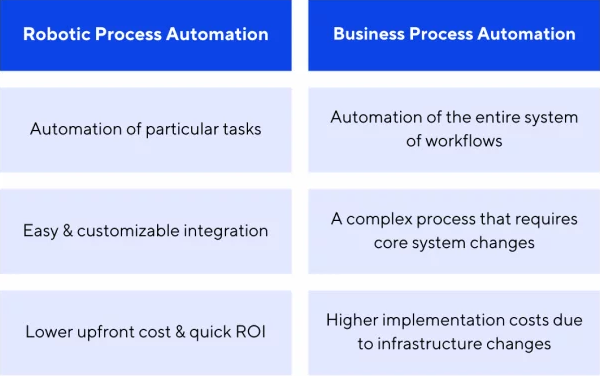Robotic Process Automation (RPA) may be a technology of choice to automate business processes. However, the question arises - if software robots are needed for automation, why implement them when the company already has an IT system and everything works well. The answer is that RPA helps get rid of routine as much as possible and virtually eliminates manual work at the computer.

What is BPA?
Classic business process automation (BPA) is the use of special technology to complete business processes with minimal human intervention. For example, a CRM system is used for analyzing a company's sales.
In larger companies there is usually a set of IT systems. One may be responsible for accounting, the second one for marketing automation and the third one for logistics processes. All these systems can be integrated. This makes it possible to ensure that employees work with the same data, to speed up information processing in different systems, and to reduce the risk of errors. This kind of integration usually requires the involvement of developers, who adjust the current IT infrastructure to solve specific tasks.
The tasks that the automation solves include:
- preparation of documentation and reporting;
- information storage;
- calculation of payroll and other payments;
- nomenclature management.
Automation reduces the amount of routine tasks previously carried out by employees. It increases business efficiency and improves customer service.
What is RPA?
RPA is a software tool for the robotization of business processes. Software robots mimic human actions and perform the same tasks as an employee. If a process consists of several steps and can be described by a flowchart, the robot can perform the process itself.
RPA can be considered a more flexible automation option. Robots are not embedded inside a company's IT system, but work on top of it. Digital workers are just like humans, making clicks and entering data, so they can work with several systems, services and websites to solve a single task.
Software robots can enhance the effect of business process automation. They can operate in several systems at the same time. This eliminates the routine transfer of data between the programs and the checking of the correctness.
BPA and RPA: similar, but different
Both classical automation and robotic process automation do what they do best - they take the human out of the routine. However, there are differences. They are worth considering when choosing a solution for implementing new technologies in a company.
Infrastructure change
When it comes to enterprises, IT infrastructure includes many corporate systems with modules and third-party services. Some of these may have become obsolete, written by employees who are no longer with the company. If the company wanted to integrate all systems, the structure would need to be changed.
Implementing RPA solutions does not require such a sacrifice. Software robots can easily work within the existing IT system.
Cost of implementation
The cost is directly derived from the previous point. Classic BPA costs companies much more. However, its cost may not always be justified. For example, if the business has not estimated the importance of the process, the time spent on it, there is a risk of getting an automated process that does not bring a noticeable result.
RPA is a more reliable option for such cases. The cost of implementation is much lower. If the robot covers most of the routine tasks, the investment can be returned in as little as a month.
Speed of implementation
Business process automation will require changes to the IT system. And to implement the changes, you will need to hire additional specialists to tie together the modules of the corporate systems. RPA is an out-of-the-box solution. The first robot can be implemented within a month.
BPA and RPA: what to choose?
Essentially, BPA is the more profitable option when the business is not fully automated. However, larger companies usually already have IT systems in place. In order to integrate them you would need to write the code manually. This is expensive and time-consuming. This is exactly where a robot can help. It will supplement the current infrastructure and take over manual tasks.
For example, an enterprise has a procurement management center and a database with hundreds of counterparties. This database has to be checked regularly to see if the company has gone bankrupt or left the market. This task requires hiring dozens of people, which is not profitable for a business, so information about counterparties is checked only when a transaction is made. It is more profitable to program a robot to do only the checking and always provide up-to-date information.
Additionally, robots help assess the need for further automation. For example, a company has a business process for which several systems need to work simultaneously. Executives are confident that classic BPA will help remove manual work from employees. At the same time, it is not clear whether it is worth deploying business process automation - it simply may or may not pay off. A robot will allow you to test this without any large financial investment and without employing a large team of specialists.
Our experience shows that RPA is ideal for both large, and small to medium companies. Businesses succeed in debugging processes that cannot be solved by BPA and do so in a short time.
Reach out to learn how PIX RPA can optimize your business & schedule a free consultation with our specialist today!